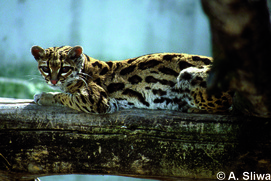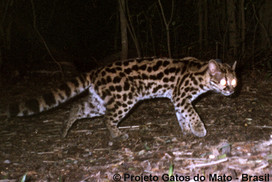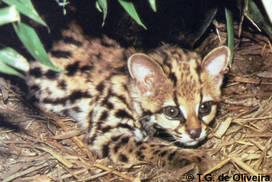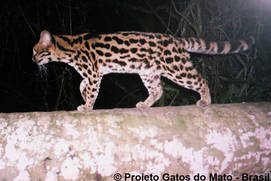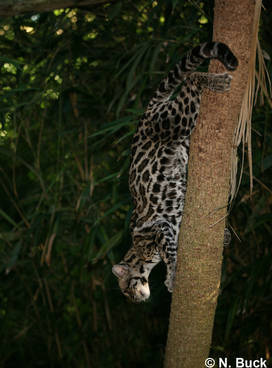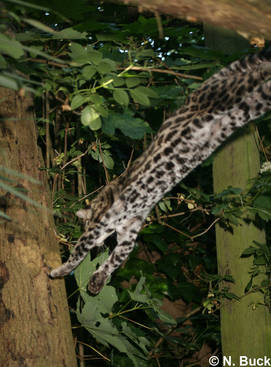Margay
Leopardus wiedii
IUCN Red List: Near Threatened
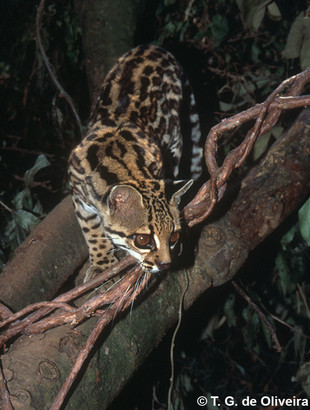
| Weight: | 2.3-4.9 kg |
| Body length: | 46-69 cm |
| Tail length: | 23-52 cm |
| Longevity: | up to 22 years |
| Litter size: | 1-2 cubs |
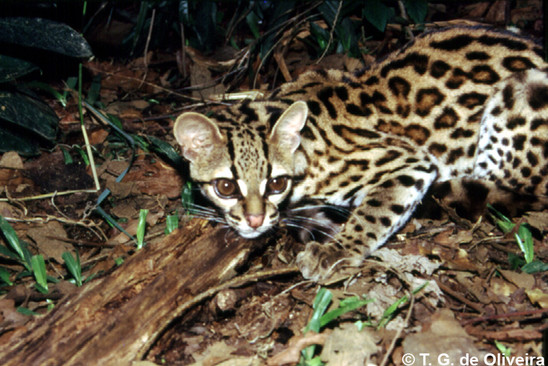
Description
The margay (Leopardus wiedii) makes part of the ocelot lineage. It is genetically very diverse, and three phylogeographical groups were suggested: Central America, South America north of the Amazon and South America south of the Amazon. However, further molecular and morphological studies are required. Until then, three subspecies are recognised:
- Leopardus wiedii wiedii in South America south of the Amazon
- Leopardus wiedii vigens in South America north of the Amazon and
- Leopardus wiedii glauculus in Central America
The margay looks similar to the bigger ocelot (Leopardus pardalis) and the smaller tiger cats (Leopardus tigrinus and Leopardus guttulus) which have similar coat patterns and colours. Paying closer attention, size-wise, it is closer to the tiger cats but in appearance-wise it resembles the ocelot. No wonder in some parts of South America the margay is even called “little ocelot”. The distinguishing features of margays include the very large and bulging eyes, which gives the muzzle a kind of narrow, but prominent appearance. Another distinguishing feature is its proportionally very large paws and very long tail measuring up to 70% of the head and body length and which is usually thick in appearance. The long tail acts as a counterweight to help maintain balance. The margay has a thick and soft fur, which renders one of its common names in northern Brazil, “gato-peludo” or “fury cat”. The base colour is typically yellowish but can also go towards a rather brown colour. The coat is patterned with dark brown or black rosettes. These are usually rounder and in fewer numbers than the other species, and sometimes can almost look like a big spot. Some individuals have elongated rosettes, arranged in longitudinal rows, similar to the ocelot’s. Its underside and belly are white, the cheeks marked with two stripes and the back of the ears are black with central white spots similar to those of the ocelot and tiger cats. The tail of the margay is marked with usually large dark rings. Compared to other cat species the margay shows low sexual dimorphism. Only in 2013 in Colombia and in 2014 in Costa Rica, the first observations of melanism in margays were reported.
In Colombia and Ecuador, hybridisation between L. wiedii and L. tigrinus was found.
Language/Country | Name |
|---|---|
Argentina | gato pintado |
Belize | tigrillito |
Bolivia | gato montés, gato de monté |
Brazil | gato montés, gato-peludo, |
Central America | pichigueta |
Costa Rica | caucel |
Ecuador | burricón |
French | margay |
French Guiana | chat tig, chat margay |
German | Langschwanzkatze |
Guatemala | mbaracaya |
Guyana | kuichua |
Honduras | caucel |
Mayan | chulul |
Peru | gato pintado, huamburushu |
Spanish | tigrillio, gato tigre |
Surinam | tigrikati, boomkat |
Uruguay | gato montés, gato de monté |
Venezuela | gato pintado, cuanguaro, huamburushu |
Status and Distribution
The margay is classified as Near Threatened by the IUCN Red List as well as in the National Red Lists of Bolivia and Colombia. In Costa Rica and Mexico, it is considered as Threatened, and in Argentina, Brazil, Ecuador, Nicaragua and Venezuela as Vulnerable. The margay’s distribution range extends from the lowlands of northern Mexico into Central and South America to Uruguay and northern Argentina. Its occurrence as far north as Texas could have been occasional or of dispersing individuals, rather than an extant population. A range wide habitat suitability model estimated a range of approx. 1.5 million km² of highly suitable habitat for the margay, 5.9 million km² of moderately suitable habitat and 7.1 million km² habitat with a low suitability. The highly suitable habitat was mostly found in Brazil’s Atlantic forest, as well as the forests of southern Mexico, Belize and Guatemala.
In areas where ocelots occur, the margay tends to be rare because of potential intra-guild predation/competition. This negative impact of the ocelot on smaller cat species is called the “ocelot effect”. Thus, margay numbers are negatively impacted by the larger ocelot by interspecific killing due to potential for competition. Margay numbers are not affected by those of the smaller sized and, in fact, more potential competitors, the jaguarundi and the tiger cats. In Amazonia and Central America, of the tropical small-medium sized felid guild, margay usually ranks second in abundance behind ocelot. In Atlantic rainforests, it alternates the second position with the southern tiger cat, but it is usually the least abundant felid in open habitats.
Margays generally are uncommon to rare throughout its range, and only in very few areas they can be relatively common. Generally, its densities are between 1–5 individuals per 100 km². Only in a very few areas it seems to reach densities of up to 15–25 per 100 km². Some very high densities were estimated in the state of Oaxaca, southeastern Mexico: in the Los Chimalapas region, a density of 68 individuals per 100 km² was estimated, and in the Sierra Norte a density of 81 individuals per 100 km². In both areas, ocelots occurred too (22 and 7.8 individuals per 100 km², respectively). In Los Chimalapas, the larger ocelot was even captured more often on camera, but fewer individuals were identified.
Habitat
Compared to other tropical American cat species, the margay is strongly associated with forest habitat and lives predominately in tropical and subtropical evergreen, deciduous/semi-deciduous, pre-montane humid and very humid forests, and montane cloud forests. Margays were also found in floodplain or seasonally flooded forests. In open formations such as savannas and wet-swampy savannas it is usually found in gallery forests, but was registered in semi-arid caatinga thorny scrub, too. Only occasionally it has been reported outside forested areas. Although the margay seems to be less tolerant to disturbance than the tiger cats or ocelot, it uses altered habitat such as disturbed forests, forest patches, or abandoned plantations, if sufficient tree cover is still available. They were also sometimes found in agriculture/forest mosaics, but not always: Margays were observed around Raphia taedigera palm plantations in Costa Rica, but not within them. In Pará, Brazil, margays were found equally within oil palm (Elaeis guineensis) plantations and surrounding primary forests. In Guatemala, the species was in one area observed within coffee plantations as well as the surrounding forests, in a second area only in the forests surrounding the coffee plantations. In Bahia, Brazil, margays were found in a rubber plantation as well as the surrounding forest reserve and riparian areas. Nevertheless, a study indicated a higher occupancy closer to reserves, where disturbance is usually lower. The margay is rarely found above 1,200 m elevation but has been recorded up to 3,000 m above sea level in the Andes.
Ecology and Behaviour
The margay is solitary, territorial and mainly nocturnal, but with some activity during the day as well. The margay rests mainly in trees and is considered to be more arboreal and to be better adapted to live in trees than other cat species. It is an excellent and agile climber and can descend a tree head first or hang from a branch by one hind foot. Its hind paws can be rotated by 180 degrees allowing them to grip equally well with the hind limbs and fore limbs. The long tail and the large paws help the margay to keep its balance.
Margays hunt mostly on the ground but can also take prey in trees. However, it travels mostly on the ground. Given its arboreal capabilities there has been a recurring myth that this cat is either scansorial or arboreal. It indeed possesses several unique arboreal skills, but that does not necessarily make it arboreal per se. In fact, evidence is highly suggestive of terrestrial locomotion and hunting, but with resting time in trees. The little information available about their home range sizes indicates variations between 1–20 km². Typically, the margay home range:body size ratio is of 3.7 km² per kilo of body mass making its home range size larger than expected value based on its body size.
Country/Region | Home range size km² |
|---|---|
Belize, Cockscomb Basin wildife Sanctuary | 11 (1 sub-adult male) |
Brazil, Iguaçu National Park | 16 (1 male) |
Mexico, El Cielo Biosphere Reserve | 4.1 (average of 4 males), 1 (1 female) |
In Mexico, there was an overlap between male ranges detected.
The gestation period lasts for 76–84 days, the estrus cycle for 32–36 days and the estrus for 4–10 days. Females have only two teats and generally have only one kitten, exceptionally two. Average litter size in Brazil was 1.09. The eyes are open at 11–16 days, while solid food is first taken at 52–57 days. Maturity is achieved at 9–12 months, whereas reproduction typically starts at two years of age, which is rather late for a felid of this size when compared to species from other lineages. Margays do not reproduce easily in captivity, and often most zoo animals are wild born.
Remains of margay were found in scats of jaguar and puma in Quintana Roo, Mexico.
Prey
Most prey species of the margay are nocturnal. The margay feeds on both terrestrial and scansorial small mammals (< 0.6 kg), birds and reptiles. Larger medium sized mammals like squirrels, rabbits, agoutis, or small monkeys are also taken, but to a lesser extent. In Manaus, Brazil, a margay was observed trying to attract pied tamarin (Saguinus bicolor) by mimicking their calls. Typically, small rodents form the bulk of the diet, but lizards and especially birds can comprise important items at some sites. At the study site in Belize, scansorial prey was a considerable part of the diet. However, at most sites in Brazil, typical prey were mostly terrestrial. Average mean prey mass taken by the margay is about 250 g, which is intermediate between those of tiger cats and jaguarundi. Although there might be some overlap in prey preference, these cat species have different principal prey species.
Main Threats
The margay was one of the most heavily exploited cat species in South America and from the mid-1970s to the mid-1980s a minimum of over 125,000 margay skins were traded. In some areas illegal hunting still takes place. Habitat fragmentation and destruction mostly in form of deforestation and conversion of native forests into agricultural areas, pastures and infrastructure (e.g. hydroelectric dams) are considered to be the major threats today. Margay populations especially outside the Amazon basin are severely fragmented and are being reduced by habitat conversion to plantations and pasture. Road kills, illegal trade for the pet market and retaliatory killing due to poultry depredation are also threatening the species. The margay is susceptible to disease outbreaks and has a low reproductive rate which makes it even more vulnerable. Moreover, a study in the Atlantic Forest of Rio Grande do Sul, Brazil, found margays to be negatively affected by the presence of the invasive wild pig.
Some local communities from across the margay’s range are reported to hunt this species for its fur, as pet, but also for bushmeat, and for medicinal and cultural purposes.
Conservation Efforts and Protection Status
After the extensive exploitation of the margay it was included in the Appendix 1 of CITES in 1989. Now it is fully protected over most of its range. Hunting and trade are prohibited in Argentina, Bolivia, Brazil, Colombia, Costa Rica, French Guiana, Guatemala, Honduras, Mexico, Nicaragua, Panama, Paraguay, Peru, Suriname, Uruguay and Venezuela. In Ecuador, Guyana and El Salvador it is not legally protected.
Very little is known of the status and abundance of the margay. The margay populations in protected areas outside the Amazon basin, are assumed to be very low and not to be viable in the long term (maybe due to the ocelot effect). The species could be classified as Vulnerable in the future, and periodical reviews are of high importance. Furthermore, more studies on the ecology, demographics, natural history, status and threats of the margay are needed to support adequate conservation efforts.
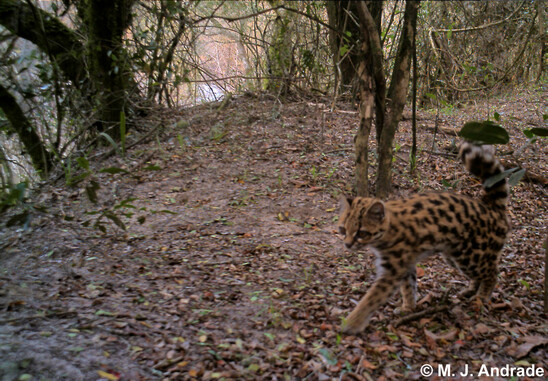
- Camera trap picture of a margay in a gallery forest on an area of young exotic tree plantations (Eucalyptus spp.), Department of Rivera, Uruguay



